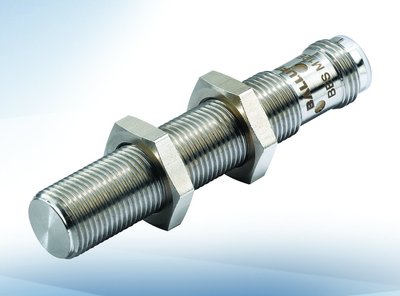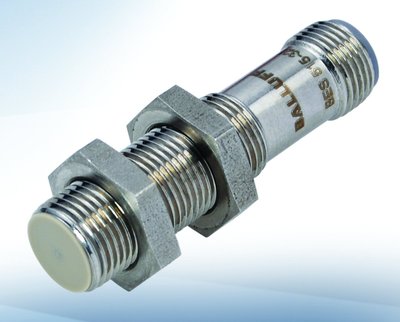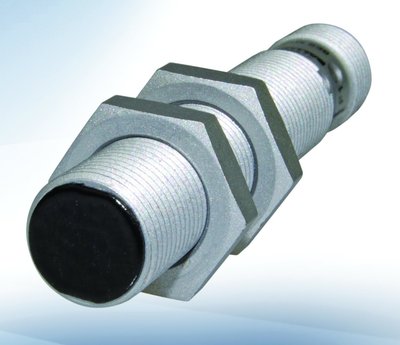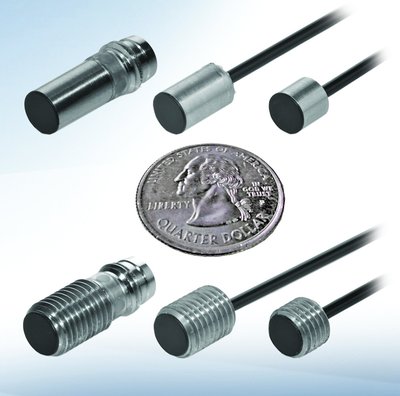Inductive proximity sensors for special applications
Monday, 09 July, 2012
Users of inductive proximity sensors can select from a vast array of standard types to solve almost any general-purpose sensing application. Unfortunately not all industrial sensing applications fall into the general-purpose category.
Many applications have unique requirements such as the need to function in extreme hot or cold temperatures; the ability to withstand repeated physical impact with minimal damage; the necessity to be impervious to food industry cleaning agents and high-pressure washdown procedures; and in some applications survive in an aggressive welding environment. What if the available mounting area is confined and even the smallest ‘general purpose’ sensors are still too large? What if the machine being monitored is a vital piece of equipment where unexpected downtime is unacceptable?
All of these are legitimate requirements in the industrial environment and specialised inductive proximity sensors exist to meet these unique needs. Each special application will be explored further and the available sensor solutions will be discussed.
Extended temperature range
As specified in IEC 60947-5-2, the standard temperature rating of an inductive proximity sensor is -25 to +70°C. Some applications such as continuous outdoor use or indoor freezers may require sensors to operate below -25°C. Applications close to molten steel or glass operations may require sensors that operate above +70°C. It is common for manufacturers to provide sensors that have extended low and high temperature ranges in the same sensor. Ratings such as -40 to +85°C or -40 to +100°C are typical. These models solve a large number of ‘extended temperature’ requirements but for some applications these combination models cannot meet the temperature levels needed.
Other manufacturers concentrate on meeting the true extreme needs of low temperatures (down to -60°C) or extreme high temperatures (up to +250°C). Sensors designed for extreme low temperatures are built with special attention to differences in the coefficient of thermal expansion of the various materials that go into the product. Adjacent materials with incompatible rates of thermal expansion may lead to separation and component breakage.

What about high-temperature models? High temperature-rated sensors can handle temperatures above the maximum ratings of most solid-state components. The vital electronics are housed in a remote-mounted module where they can be protected from direct exposure to extreme temperatures; the basic copper-wound coil is the only component that actually experiences the high ambient heat. The construction of high-temperate sensors typically employs a stainless steel housing and a cable jacket made from Teflon (PTFE) or silicon to resist chemical breakdown at high temperatures.
Impact tolerance
It is estimated that almost 70% of all inductive proximity sensor failures are caused by direct impact to the sensor face. Standard sensors are not designed to handle impact; in fact they are non-contact sensing devices. Nevertheless, manufacturers understand the problem is often unavoidable and are continually testing various materials in an effort to create a more robust sensor face.
One of the more popular face materials used today is stainless steel. Because an inductive proximity sensor is designed to detect the presence of metal in front of the sensing coil, it seems counterintuitive that a metal-faced sensor is even possible. However, through careful engineering it is possible to tune an inductive sensor’s internal circuitry to ignore its metal face and respond only to external targets.

Many of these stainless steel-faced sensors feature a housing that is gun drilled from one end of a solid steel bar. Gun drilling results in a single-piece housing where the body and face are one integral unit without any seams or gaps. The housing materials vary, but most are made from 303 or 316 stainless steel. Some sensor models have a stainless steel face almost 0.75 mm thick, providing tremendous physical protection to the vital sensor coil. In repeated impact applications such as manual part loading and unloading, these metal-faced sensors can last up to ten times longer than general-purpose inductive sensors. Metal-faced sensors are available with standard, double and even triple sensing ranges. Some target-selective versions are also available, which are specially tuned to detect ‘ferrous only’ or ‘non-ferrous only’ target materials.
High-pressure washdown
Many food and beverage applications require the processing areas to be washed down daily with high-pressure water or cleaning solutions to maintain sanitary standards. As specified in DIN 40050-9, an IP69K rating is defined for high-pressure, high-temperature washdown applications. These enclosures must be dust tight and must also be protected against directed high-pressure water (1500 psi) and steam cleaning (up to +80°C).
Many inductive proximity sensors are available with an IP69K rating and are the right models to use for this type of application. An IP69K-rated sensor may cost more than an IP67- or IP68-rated model, but its performance is worth the extra expense. A less-expensive IP67- or IP68-rated model may last for a short while but its repeated replacement costs will squander any savings realised on the initial installation.

IP69K-rated sensors are typically manufactured with stainless steel housings with integral cable or connectors and are available with or without function LEDs. If a connectorised sensor is chosen, a matching IP69K-rated mating cordset should be used to maintain the IP69K environmental rating.
Welding environments
The automotive body and frame industry, the whitegoods appliance industry and other metal-forming industries employ many welding operations to produce a final product. These weldments include frame structures, body panels and under-body support components that must be welded to properly form the subassemblies. Automated or manual weld cells create very hostile sensor environments due to high ambient temperatures, weld-slag generation, part-loading impact and the presence of strong electromagnetic fields.

Uniquely designed inductive proximity sensors exist specifically to survive in this harsh environment. They have weld field immune (WFI) electronics, incorporate slag-resistant body coatings (such as PTFE) and have high temperature-rated face materials (PTFE or similar material). The faces on these sensors tend to take the brunt of the welding abuse; therefore some manufacturers offer optional ceramic-based face coatings to protect and extend the life of the sensor face. Many WFI sensors on the market also offer multi-metal detection at the same sensing range. These sensors are commonly referred to as Factor 1 or F1 models, since they have no sensing range reduction factor for nonferrous materials like aluminium. Stated another way, the range reduction factor for all metals is equal to the standard sensing distance for steel. Standard inductive proximity sensors typically experience a reduction in range of 0.5 or 0.4 when the target material is aluminium or some other nonferrous material. Factor 1 sensors do not have this range reduction and offer a performance advantage to customers who have the need to detect nonferrous metals.
Extremely compact physical size
To reduce machinery weight and shipping costs, and to cut costly factory floor space requirements, machine manufacturers strive to keep their equipment designs as compact as possible. These newer, smaller models are not expected to compromise on performance - in fact they are expected to outperform their larger predecessors. Additional automation is how this added performance is accomplished and sensors play an integral role. Historically M8, M12, M18 and M30 tubular sensors have been the sensors of choice, but these are starting to be replaced with smaller sensors of 6.5 mm, M5, 4 mm and 3 mm diameter. This new generation of mini sensors is smaller in diameter, length and weight - all of which are important. To accommodate some of the shorter sensor housing lengths (less than 20 mm long), a separate amplifier module is often placed in line with the sensor cable. This design eliminates many components from the sensor head thus allowing it to be lighter and smaller in size. More recently, ultrashort 6.5 mm diameter and M8 tubular sizes have come on the market incorporating fully integrated electronics. This new design eliminates the inline amplifier, thus saving overall space and weight. These models are available with integral cables having overall housing lengths of only 6 and 10 mm, and with M8 connectors having body lengths of only 18 mm.

Reliable diagnostics
Reliable diagnostics are extremely important for high-throughput machines. These machines depend on the ability to identify process quality issues in real time. Examples of these types of machines can be found in the printing and paper-converting industries. The sensors on these machines need to be highly reliable and have their proper functioning guaranteed. Some sensor manufacturers are now incorporating internal sensor diagnostics that generate dedicated status outputs for monitoring via the host control system. These diagnostics allow the controller to verify the sensor’s signal integrity and monitor the health of the sensor itself. Rather than experience an unforeseen sensor failure or improper signal output, the status of the sensor can be continuously monitored to recognise the need to replace or readjust the sensor before it fails or fails to operate correctly. This diagnostic capability allows for planned maintenance activities rather than unplanned downtime. This diagnostic functionality is now available with certain inductive, capacitive and photoelectric sensors.
Summary
All inductive proximity sensors are not created equal. While the vast majority of inductive proximity sensors work well for general-purpose applications, specialty inductive sensors allow highly reliable sensing performance in applications where general-purpose types are insufficient. It is important to understand the limitations of a standard inductive proximity sensor and know when to select the unique performing capabilities of a special-purpose sensor.
Performance without compromise: enhancing manufacturing quality with single-controller solutions
Most factory automation systems today have mutiple control systems that don't communicate...
From wartime wisdom to smart manufacturing: the power of condition monitoring
The shift from reactive to predictive maintenance is really a cultural transformation empowered...
Efficiency in intralogistics: AMRs and industrial 5G
How industrial 5G enhances AMR applications and performance.







